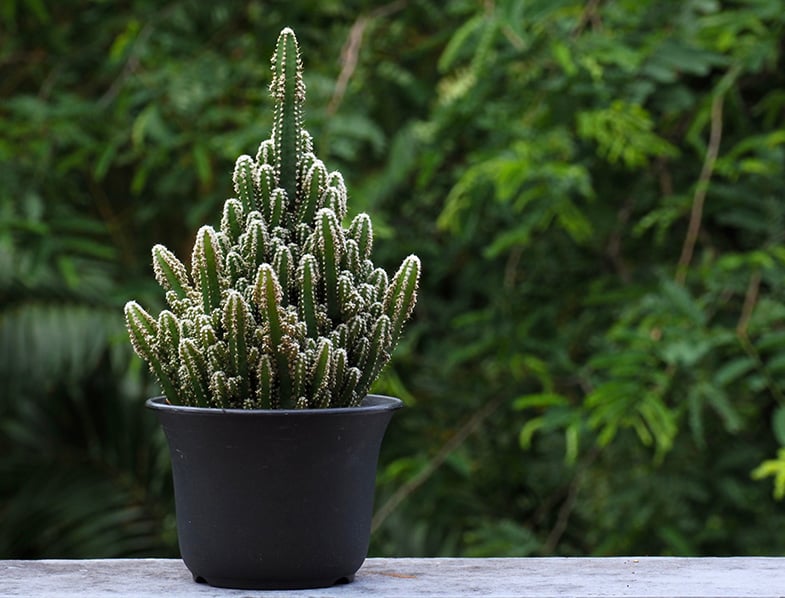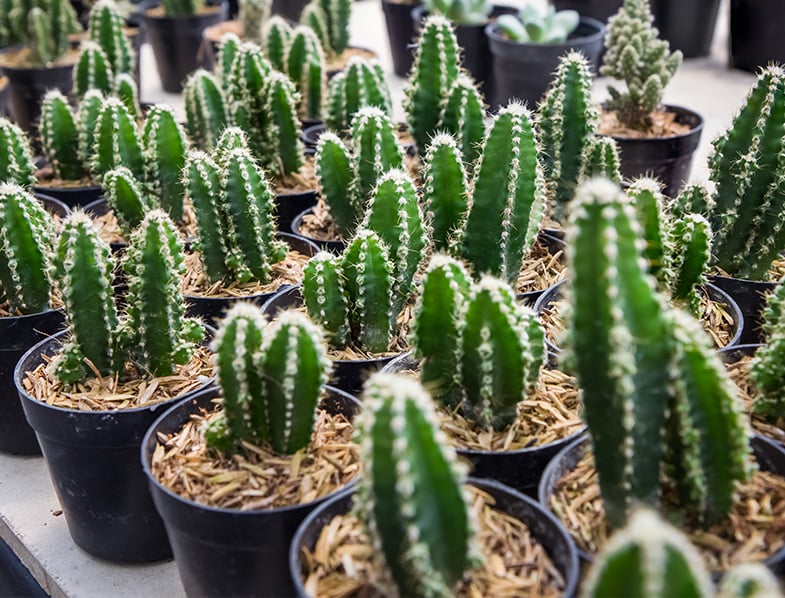Cacti are, by far, the most spectacular, low-demanding, and exciting companions to have around. And Fairy castle cactus is no different! If you are a big lover of cacti and unique plants in general, this adorable cactus cannot be missing from your collection.
Acanthocereus tetragonus (formerly Cereus tetragonus) is a species of flowering cacti in the Cactaceae family. Fairy castle cactus, also known as the Triangle Cactus, is actually a miniature cultivar of the alluring Acanthocereus species. This cactus features numerous curved branches that look very similar to the turrets of a castle, hence its common name.
Fairy castle cactus is a perfect ornamental for every type of gardener, especially beginners or forgetful ones. This cactus thrives in lots of sunlight, warm to hot weather, well-draining soils, and it is also drought-tolerant for prolonged periods. In conclusion, the plant can basically take care of itself as long as you can simulate the environmental conditions from its native habitat.
Keep reading to find out everything you need to know about Fairy castle cactus!
About Fairy Castle Cactus
- This plant is native to northern South America, Central America, Mexico, the Lower Rio Grande Valley of Texas, Florida, and the Caribbean. Acanthocereus tetragonus ‘Fairy Castle’ is invasive in New Caledonia.
- Its genus name “Acanthocereus” derives from the words “acantha”, which is the Greek for “spine”, and “cereus”, which is the Latin for “candle”. The specific epithet “tetragonus” refers to the four-sided branches of this cactus.
- Fairy castle cactus grows most often in hot and dry coastal habitats, sandy coastal habitats, and coastal hammocks. In its natural habitat, this cactus usually forms thickets that can be super spiny and impenetrable.
- Fairy castle cactus does not withstand cool weather overall, so make sure you keep it away from cold winds. Also, indoor-grown specimens will require protection from cold drafts or air conditioning.
- Acanthocereus tetragonus ‘Fairy Castle’ can be a wonderful addition to various landscape decorations. This cactus works well in desert gardens, cacti gardens, tropical gardens, xeriscape gardens, rock gardens, succulent gardens, and also pots.
- Fairy castle cactus will look absolutely gorgeous near many other ornamental species. For the best display, plant this buddy with cacti, succulents, and other types of plants that have similar sizes and growing requirements.
- While the flowers of Fairy castle cactus appear pretty rarely, they surely put on a bewitching show when they do. The flowers are also attractive to hummingbird moths.
- Some parts of Fairy castle cactus are edible. For example, its young stems can serve as an excellent vegetable either raw or cooked. Likewise, the fruits of this cactus are very juicy and have a sweet flavour.
- The fairy castle cactus is not as harmful to humans and animals as other species of cacti. However, its spikes can easily sting a curious kid or pet. Due to this, we warmly recommend growing this cactus where your beloved ones cannot reach it.

Fairy Castle Cactus Features: An Overview
- This cactus belongs to the Acanthocereus genus that contains exactly 14 species of cacti. Fairy castle cactus is the somewhat representative cultivar of this genus.
- Fairy castle cactus is a tall, columnar perennial plant. This cactus can reach up to 6 feet (2 m) in height. It tends to grow at a very slow pace with time and produces numerous branches that provide an attractive silhouette.
- The plant consists of many tall, four-sided, light to dark green stems that feature wool-like spines along each plane. Its limbs turn woody and brownish with age.
- In general, the Fairy castle cactus exhibits blossoms quite rarely. But when it blooms, the flowers appear only during the night and remain open until dawn. The flowers do not usually show up until the cactus is ten years old or even more.
- The showy flowers of Fairy castle cactus have lots of delicate, long, pointy, and white petals. They have dense, creamy white or yellowish centres (pistils).
- Once its blooming period has ended, the Fairy castle cactus may bear fruits where the blooms were before. The fruits are tiny, shiny, spiny, ovoid to oblong, reddish, and measure about 2 inches (5 cm) in length.
Growing Fairy Castle Cactus
Fairy castle cactus, like many other species that come from dry areas, grows at its best when it receives plenty of sunlight. Make sure you choose a spot for your cactus where it can experience at least six to eight hours of bright, direct light. In indoor settings, place your Fairy castle cactus in front of south, north, or west-facing windows for optimal results.
Fairy castle cactus might appear very independent at first, but it is not as hardy as it meets the eye. As long as it receives enough water, the cactus will do just fine in hot temperatures. However, this plant is winter-hardy only in the USDA zones 10 to 11, making it very sensitive to cooler temperatures or frost. If the outdoor temperature in your area reaches 32 °F (0 °C), it is wise to grow your Fairy castle cactus in a pot and bring it inside once it happens.
Sometimes, the columnar stems of Fairy castle cactus may present brown spots. In general, this issue is a common sign that your cactus is fighting a pest infestation. The pests that typically infest Fairy castle cacti include mealybugs, aphids, scale insects, and fungus gnats. If you notice something unusual on your cactus, remove the unhealthy parts using a sterilized knife, then provide the plant with neem oil or insecticidal soap until the infestation is gone.
Planting Fairy Castle Cactus
When it comes to the growing medium, Fairy castle cactus thrives in those substrates that come with excellent drainage. If you want to use the soil from your garden, we suggest you mix it with large amounts of sand, perlite, gravel, or bark to improve its drainage. If not, you can plant this buddy in commercial soil designed for cacti and succulents. For indoor specimens, an unglazed clay pot is an ideal candidate to help excess moisture to evaporate.
Fairy castle cactus will benefit from applications of fertilizers once in a while. However, you should avoid fertilizing your cactus when it goes dormant, usually in winter. Feed this plant with a cactus fertilizer diluted at half strength once every month from spring through autumn.
3 Lívẹ Plạnts Ạcạnthocẹrẹus Tẹtrạgonus ‘Fạíry Cạstlẹ’ Cạctus, From Amazon
Since Fairy castle cactus has a very slow growth habit, it will not reach its maximum potential very fast. But! This cactus needs lots of space to develop its roots and grow healthy. Because of this, you will have to repot yours once every year or whenever the plant has outgrown its container. Before transplanting the Fairy castle cactus in a pot that is slightly larger than its current one, do not forget to equip yourself with garden gloves for protection.
Watering Fairy Castle Cactus
What makes Fairy castle cactus a super easy companion to care for is its ability to tolerate drought for a long time. As a rule, it is always better to under-water this lovely cactus than to allow it to sit in soggy conditions. However, keep in mind that the plant will handle hot weather better if you provide it with constant moisture. So how can you make it happy?
Well, it is easier than you might think! The perfect way to avoid over-watering your Fairy castle cactus while spoiling it with enough water is to use the “soak & dry” method. This trick consists of watering your cactus only when its growing medium has dried out completely.
Still, the “soak & dry” is a viable option for the warmer seasons. During the dormant period of your Fairy castle cactus, typically in winter, you must water the plant less often than usual. In general, the cactus will enjoy a nice drink only once every month or so.

Propagating Fairy Castle Cactus
Fairy castle cactus is a one-of-a-kind fellow to have around, so it is only natural to want more spiny specimens in your collection! Especially when it is so easy to propagate. This cactus may produce fruits occasionally, but it usually grows super slow. In simple words, it is not a very good idea to start your own plants from seed. But do not worry! Fairy castle cactus exhibits new tiny stems regularly which are a great propagation material.
First things first, you will have to allow the branches to grow bigger. When the baby branches reach about 2 inches (5 cm) in length, you can get into action. In spring, cut off the branches at the base using a sterilized knife or scissors. Make sure you sterilize the tool before each cut to prevent your Fairy castle cactus from developing an infection.
Once you have the cuttings, you must allow the cut ends to dry out and harden off. This process is not mandatory, but it will help your small cacti to form roots much faster. After a few days, you can plant the cuttings in an unglazed pot filled with well-draining soil. Water the cuttings whenever the soil has dried out entirely and you will have your new Fairy castle cacti in several months or so.
In Conclusion
If you do not already have a Fairy castle cactus in your plant family, the Fairy castle cactus can make a perfect desk companion! With time, you will see that this cute, low-maintenance cactus is worth all the little time and effort you put in.

2 Comments
Excellent information. One question: should a fairy castle cactus’ pot be deep or shallow? Thanks.
Like most succulents and cacti, the fairy castle cactus will appreciate an unglazed clay pot with drainage holes, so you can choose a regular clay flower pot that has an appropriate size for your cactus. A cactus container should be approximately the same size as your cactus. In most cases, the roots of the cactus are not very large, so the container doesn’t need to be taller than your cactus or very deep.